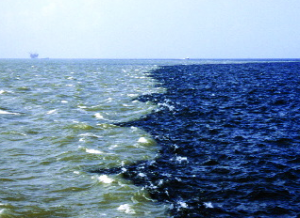Extreme Weather: A Mixed Bag For Dead Zones

This year’s extreme weather events—a warm winter, even warmer summer, and a drought that covered nearly two-thirds of the continental United States—has certainly caused its fair share of damages. But despite the crop failures, water shortages, and heat waves, extreme weather created at least one benefit: smaller dead zones in the Chesapeake Bay and Gulf of Mexico.
On a normal year, rain washes pollutants like nitrogen and phosphorous from farms and urban areas into the two bodies of water, fueling algae growth. When this algae dies, it consumes oxygen and creates hypoxic areas, or “dead zones,” which can kill fish and other marine life. Less rain this year meant fewer pollutants making their way into the Chesapeake Bay and Gulf of Mexico. The Chesapeake Bay’s summer dead zone was the smallest since record-keeping began in 1985, and the Gulf of Mexico’s covered one of the smallest areas on record.
But It’s Not All Good News
Which isn’t to say that extreme weather and climatic events decrease the incidence of dead zones overall. In fact, in some cases, extreme weather and climatic events can actually exacerbate dead zones in lakes and oceanic ecosystems.
Dead zone occurrences have dramatically increased over the past 50 years. In 1960, there were fewer than 25 reported dead zones around the world; today there are more than 500, according to WRI’s interactive map of eutrophication and hypoxia. Dead zones in freshwater and coastal ecosystems are on the rise due to the increasing use of chemical fertilizers, manure runoff from factory farms, and sewage and wastewater discharges from urban areas. The frequency and duration of hypoxic events has been exacerbated by several other human and environmental factors, including extreme weather and climatic events. Take, for example, the following cases:
•While this year’s dead zone in the Chesapeake Bay may be one of the smallest, last July’s was the biggest on record, covering more than one-third of the bay. Scientists reported that as a result of snow melt and an unusually wet spring, the bay received as many nutrients in the month of May as it normally receives in an entire year. These nutrients fueled large algae blooms, which eventually triggered the formation of the huge dead zone.
•The Cook Islands in the South Pacific recently experienced a long-lasting dead zone in the Manihiki Lagoon, which decimated the country’s black pearl oysters. Scientists blamed this dead zone on a particularly strong La Niña event. The conditions created by the La Niña—cooler-than-average temperatures and drought—resulted in stratification of the water column. When an algae bloom occurred after a rainfall event, stratification prevented the bottom waters—which had become deoxygenated from the algae die-off—from mixing with oxygen-rich surface waters. A dead zone then formed, causing 100-percent mortality for all shellfish below 16 meters.
•Starting in 2002, Oregon’s coast began to see regular dead zone occurrences in near-shore waters. Scientists believe these occurrences are due in part to climate-driven changes in the California current system that intensified wind-driven upwelling events. Upwellings are natural events where nutrient-rich bottom waters rise to the surface, causing large algal blooms and subsequent oxygen depletion. Summer winds on the Oregon coast historically blew steady for a week or so before dying down and allowing coastal systems to flush the low-oxygen water. However, warmer temperatures attributed to climate change have intensified seasonal northwest coastal winds, which can now last between 20 to 30 days, trapping low-oxygen water near Oregon’s coast. As a result, a dead zone has formed for the past 10 summers, causing marine die-offs.
•In the spring of 2011, the largest toxic algae bloom in decades formed in Lake Erie, leading to a dead zone. In part, this massive bloom was blamed on a wet spring that brought record amounts of rainfall. The rain swept pollutants from farm fields and urban areas into the lake, providing the nutrients necessary to fuel the bloom.
Climate Change May Worsen the Situation
Reports suggest that climate change may worsen extreme weather and climatic events and the occurrence of dead zones. Don Scavia, director of the University of Michigan’s Graham Sustainability Institute, recently said that increased spring rains spurred by a warmer climate will send more phosphorous into Lake Erie, inducing harmful algal blooms. A 2010 NOAA report found that the average annual size and duration of the Gulf of Mexico dead zone is expected to increase as a result of rising temperatures, changing wind patterns, and overall increases in precipitation patterns linked to climate change. And studies of Michigan’s Green Bay predict that climate change will lead to increased frequency of intense weather events and higher temperatures, which in term will prolong and intensify hypoxic events in the bay.
Indeed, climate change may pose problems for waterways across the globe. Warming temperatures have been linked to an increase in intense precipitation events—even in cases where overall precipitation has decreased. Intense storms generate runoff—meaning that our aquatic systems will be more vulnerable to pollution as storms ramp up in frequency and intensity. In addition, warmer weather will increase stratification of the water column, preventing the natural mixing that keeps waters oxygenated. Warmer temperatures can also lead to longer growing seasons—meaning that overall, we might expect algal blooms and dead zones to not only be larger, but last longer.
Dead Zones in the Future
It’s fair to say that the world is on a dangerous track when it comes to dead zones. Protecting our freshwater and coastal resources will not only require policies to reduce nutrient pollution and greenhouse gas emissions; we’ll need remediation and restoration strategies that can be resilient in the face of an uncertain climate.
You can return to the main Market News page, or press the Back button on your browser.

